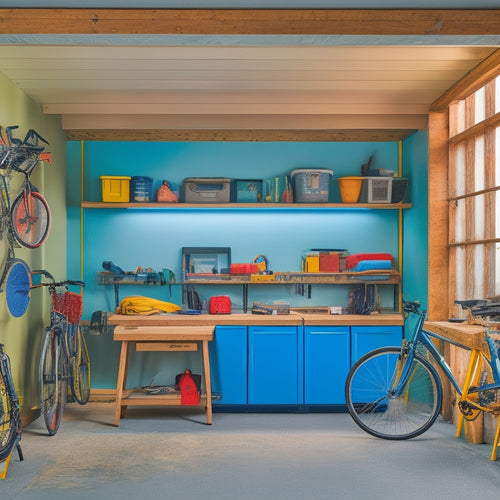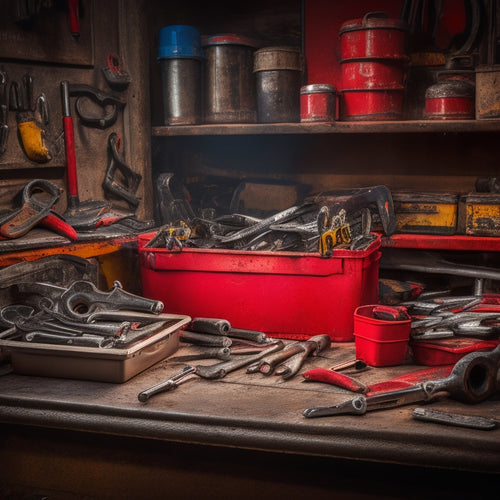
5 Best DIY Woodworking Workshop Organization Hacks
Share
You can transform your woodworking workshop into a productivity powerhouse by implementing these 5 DIY organization hacks. First, optimize your workshop layout by grouping tools and equipment by task, and utilizing vertical space for storage. Next, create a pegboard system for easy tool access and implement efficient storage solutions like mobile workbenches and hanging racks. Don't forget to maximize your wall space with shelves, cabinets, and hooks, and label each station with clarity. By applying these hacks, you'll be on your way to a more organized, efficient workspace, and the secrets to taking it to the next level are just ahead.
Key Takeaways
• Map out a functional workshop layout to prioritize tasks, optimize space, and group similar tools together for efficient access.
• Implement a pegboard system with customized hooks, bins, and accessories to hang frequently used tools and reduce clutter.
• Utilize vertical storage space with wall-mounted cabinets, shelves, or hooks to maximize storage capacity and save floor space.
• Label and sign stations clearly with easy-to-read fonts, icons, and concise descriptions to maintain a well-organized workshop and increase productivity.
• Opt for adjustable and durable storage solutions, such as sliding drawer cabinets and hanging tool racks, to accommodate various tool sizes and types.
Optimize Your Workshop Layout
Optimize Your Workshop Layout
To maximize your workshop's productivity, start by mapping out a functional arrangement that allocates a specific zone for each task, from woodworking and assembly to storage and finishing. This will help you make the most of your space and reduce clutter.
Consider your workflow and prioritize tasks that require the most space or specialized equipment. When designing your workshop layout, think vertically to optimize your ceiling height. Install shelves, hooks, or bins to store less frequently used items, keeping your floor clear for easy navigation.
Effective tool organization is pivotal for workspace efficiency. Group similar tools together, such as all your woodworking tools in one area, and consider a pegboard for hanging frequently used items. Label each zone and tool station to maintain order and save time searching for misplaced tools.
Efficient Tool Storage Solutions
Designate a home for each tool by implementing a storage system that keeps frequently used items within easy reach, while relegating less-used tools to labeled bins or shelves. This will save you time and energy by reducing the need to search for tools mid-project.
Consider investing in a mobile workbench with built-in storage, allowing you to move your workspace and tools around the shop as needed. Hanging tool racks are also a great way to maximize vertical storage and keep tools like saws, drills, and sanders organized.
For smaller items, sliding drawer cabinets can be a lifesaver, keeping parts and accessories neatly organized and out of the way. Don't forget to utilize your walls by installing wall-mounted tool holders, perfect for storing items like clamps, levels, and tape measures.
Create a Pegboard System
You can further streamline your workshop's tool storage by creating a pegboard system, which allows you to hang frequently used tools and accessories within easy reach. This efficient tool organization method maximizes your workspace efficiency by keeping essential items readily available, reducing clutter, and saving you time.
To set up a pegboard system, start by identifying the most frequently used tools and accessories in your workshop. Then, determine the best layout for your pegboard, considering the size and shape of each item. You can use pegboard hooks, bins, and accessories to customize your system. Consider grouping similar tools together, such as all your hand tools or power tools, to make them easy to find when you need them.
Utilize Vertical Storage Space
Your workshop's walls can be a treasure trove of storage space, just waiting to be tapped into with the right strategies. By maximizing vertical storage, you can save floor space and create a more efficient working area.
One effective way to do this is by installing wall-mounted storage solutions. You can use wall-mounted cabinets, shelves, or hooks to store tools, materials, and equipment, keeping them organized and within easy reach.
When choosing wall-mounted storage, consider the weight capacity and durability of the system. Make sure it can hold the weight of the items you plan to store, and that it's securely attached to the wall to prevent accidents.
You can also use adjustable storage systems that can be customized to fit your specific needs.
Label and Sign Your Stations
Three well-organized stations - a cutting station, a drilling station, and a sanding station - can help streamline your workflow and reduce clutter, but only if they're clearly labeled and signed.
You can create your own signage using materials like wood, metal, or even 3D-printed letters. Use a bold, easy-to-read font to make certain that your labels are visible from a distance. Consider adding icons or images to help identify the station's purpose. For instance, a picture of a saw can accompany the 'Cutting Station' label.
When it comes to station labeling, be specific and concise. Instead of labeling a station as 'Tools,' break it down into categories like 'Hand Tools' and 'Power Tools.' This will assist you and others quickly find what they need.
You can also add a list of the tools or materials stored at each station to avoid confusion. By implementing effective signage tips and station labeling, you'll be able to maintain a well-organized workshop that's easy to navigate. This, in turn, will save you time and increase productivity on your DIY projects.
Frequently Asked Questions
How Can I Deal With Dust Accumulation in My Workshop?
"When the going gets tough, the tough get going! You can tackle dust accumulation by implementing dust control measures, such as ventilation systems, air purifiers, and wearing dust masks, ensuring a healthier and more productive workshop environment."
What Safety Measures Should I Take When Working With Power Tools?
When working with power tools, you should always wear proper safety gear, including gloves, safety glasses, and a dust mask. Additionally, make certain you receive appropriate training on each tool to avoid accidents and maintain a safe working environment.
Can I Repurpose Old Furniture as Workshop Storage Solutions?
You can breathe new life into old furniture by upcycling it into creative storage solutions, like turning an old dresser into a tool cabinet or a vintage ladder into a shelving unit, saving space and reducing waste.
How Often Should I Clean and Maintain My Workshop Tools?
As you step into your workshop, imagine the satisfaction of finding exactly what you need amidst the chaos. To maintain that zen, you should clean and maintain your tools daily, dedicating 10-15 minutes to tidying up and scheduling deeper cleaning every 2-3 weeks.
Are There Any Specific Workshop Organization Apps or Software Available?
You'll find several apps and software designed to help you optimize your workshop layout and track tools efficiently, such as Workshop Buddy, ToolTrader, and GarageShop, making it easy to stay organized and focused on your projects.
Related Posts
-

7 Essential Foldable Workbenches for Garages
When selecting a foldable workbench for your garage, you'll want to contemplate factors such as space-saving design, ...
-

Top Wrench Tool Box Sets for Every Mechanic
You're looking for high-quality wrench tool box sets that cater to your specific needs as a mechanic. From top-rated ...
-

Custom Pegboard Storage for Your Workshop
You're looking to create a custom pegboard storage system that maximizes your workshop's space, enhances productivity...


